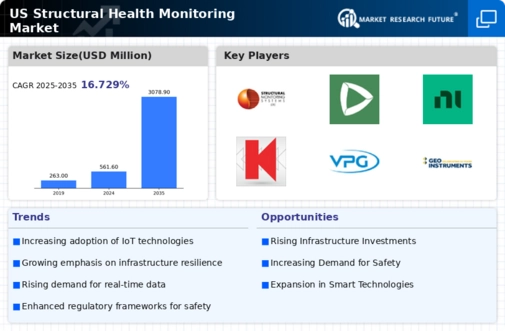The structural health monitoring market is currently characterized by a dynamic competitive landscape, driven by the increasing need for infrastructure safety and longevity. Key players are actively engaging in strategies that emphasize innovation, partnerships, and regional expansion. For instance, Geosyntec Consultants (US) has positioned itself as a leader in providing advanced monitoring solutions, focusing on integrating cutting-edge technology into their offerings. Similarly, Mistras Group (US) has been enhancing its service portfolio through strategic acquisitions, thereby broadening its market reach and capabilities. These strategies collectively contribute to a competitive environment that is increasingly focused on technological advancement and service diversification.
In terms of business tactics, companies are localizing manufacturing and optimizing supply chains to enhance operational efficiency. The market structure appears moderately fragmented, with several players vying for market share. However, the influence of major companies like Keller Group (US) and RST Instruments (US) is notable, as they leverage their extensive networks and resources to establish a strong foothold in the market. This competitive structure fosters an environment where innovation and strategic partnerships are essential for maintaining a competitive edge.
In November 2025, Keller Group (US) announced a strategic partnership with a leading technology firm to develop AI-driven monitoring solutions. This collaboration is expected to enhance their service offerings, allowing for real-time data analysis and predictive maintenance, which could significantly improve infrastructure management. The strategic importance of this partnership lies in its potential to position Keller Group at the forefront of technological innovation in the market.
In October 2025, Mistras Group (US) launched a new suite of digital monitoring tools aimed at improving the accuracy and efficiency of structural assessments. This initiative reflects a broader trend towards digital transformation within the industry, as companies seek to leverage technology to enhance service delivery. The launch is likely to strengthen Mistras Group's competitive position by offering clients more sophisticated and reliable monitoring solutions.
In September 2025, RST Instruments (US) expanded its operations into the Southeast region, establishing a new facility to better serve local clients. This move not only demonstrates RST's commitment to regional growth but also highlights the importance of localized service delivery in enhancing customer relationships. The strategic expansion is anticipated to increase RST's market share and improve its responsiveness to client needs.
As of December 2025, current trends in the structural health monitoring market are heavily influenced by digitalization, sustainability, and the integration of AI technologies. Strategic alliances are increasingly shaping the competitive landscape, enabling companies to pool resources and expertise. Looking ahead, it is likely that competitive differentiation will evolve from traditional price-based competition to a focus on innovation, technological advancements, and supply chain reliability. This shift underscores the necessity for companies to adapt and innovate continuously to maintain their competitive positions in an ever-evolving market.























Leave a Comment